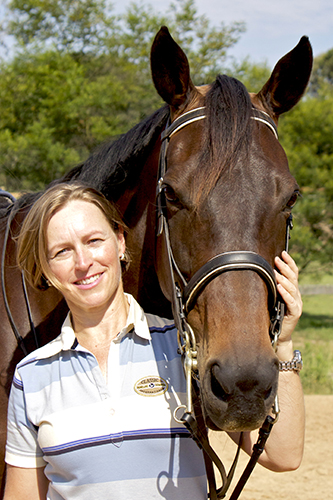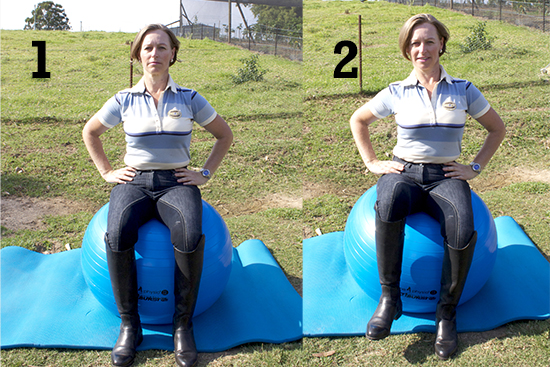Some dressage riders do it. Some don’t do it. Is it really necessary? Off-the-horse fitness for riders has become more popular in recent times, particularly in the world of eventing. Like any sport, competition in horse sport has become increasingly fierce, especially as more cash has been invested. The horses are being bred better and the training systems are being defined and redefined. As a result, the scores keep creeping towards the top side, with records being broken more regularly. With the competition narrowing, each point becomes more important. Sport has become big business. Every rider will use anything at his disposal to get that extra advantage. This is where off-the-horse fitness steps in.
Athletes know that the fitter they are, not only is the body more able to do the job asked of it, but so is the mind. Focus remains stronger for longer. This is important for any discipline, from the Grand Prix Dressage test to a four star cross-country course and everything in between. So is the ability to move the body correctly and effectively from the pelvis. And the less you interfere with the horse’s balance when he’s doing piaffe or a canter pirouette, or going over an enormous fence, the better off he’ll be.
However, is it necessary for dressage riders to do extra physical work for fitness and body awareness when they are already riding eight horses a day? Should groundwork for riders be reserved for the one-horse-a-day amateur? It would seem that there is mixed consensus within the elite. We can begin with looking at the dressage rider most recently in the spotlight. A recent visitor to our shores, Edward Gal was breaking records all over the place on Totilas before the stallion’s sale to Germany. Edward’s business partner Nicole Werner tells me, “Edward’s only exercise is riding eight horses a day.” Only? I think that would be enough exercise for anyone.
On the other hand, the Queen of Kür, Anky Van Grunsven, as well as her dressage and now reining training, also undertakes the following fitness activities a few times per week. Trampoline exercises, exercises on a fit ball for balance, running sessions on the treadmill and also work on a cross walker. I remember my trainer in the UK, Olympian and 18-times national champion Vicki Thompson-Winfield also telling me she liked the cross walker. Imke Schellekens-Bartels has swimming as her chosen fitness activity to stay in shape and relax the body. She has also worked with our own Richard Weis who is very well known in Europe for his approach to body awareness for riders, mainly through the Alexander Technique. Matthias Alexander Rath, Totilas’ new rider is another in this category. He has a professional therapist helping him out before every major competition. Additionally, Matthias does a lot of un-mounted exercises everyday, especially for his back, pelvis, legs and arms.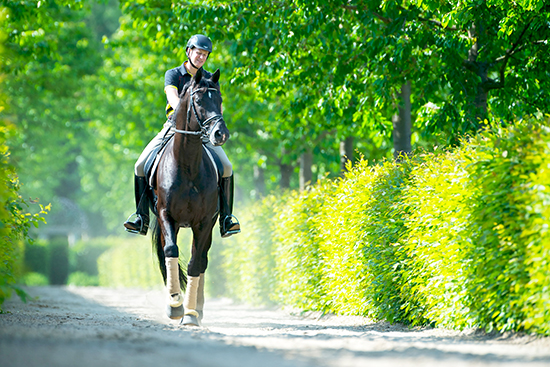
Matthias Rath (above) and Laura Bechtolscheimer (below) are two riders who improve their off-the-horse fitness through their preferred methods of exercise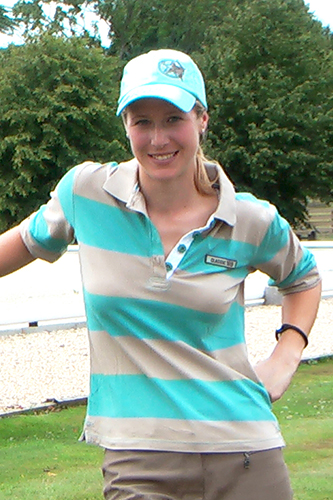
Other riders who like to improve their cardio fitness with the odd run are Anabel Balkenhol and Laura Bechtolscheimer. Laura is also a big lover of pilates, taking sessions twice a week and has also been known to hit the studio with performance coach Jon Pitts (www.jonpitts.co.uk). Jon is as expert as you will find when it comes to off-the-horse training. UK based, he works with numerous elite athletes from different sports and has become well known with the top in the equestrian world, being part of the UK World Class program involving all the Olympic disciplines. He has also been associated with Equestrian Australia for the last couple of years and has additionally worked with Australian riders in Europe such as the Fredericks and Paul Tapner. Jon was in Australia in May 2011 for the Sydney CDI and Weekend of World Cups eventing to take a look at our elite riders and returned in October to advise those on the road to London. With a background in sports science and neurology, Jon offers the following opinion, “Over the years in equestrian sport I’ve driven forward a lot of research to back up my belief that the rider plays a far more important role than most think. The trouble is, the traditions of horse riding are that we are very much the master and that the animal should cope with us easily. This is magnified by the subconscious fear we have of horses in that they are far more powerful and warrant respect from us. But we are getting somewhere now! Most of the riders/jockeys I work with are elite athletes who understand that to compete at the highest level is now not just a matter of having a good horse, but it means respecting that we limit the horse’s ability and therefore we are looking to proactively help the horse as a partnership.”
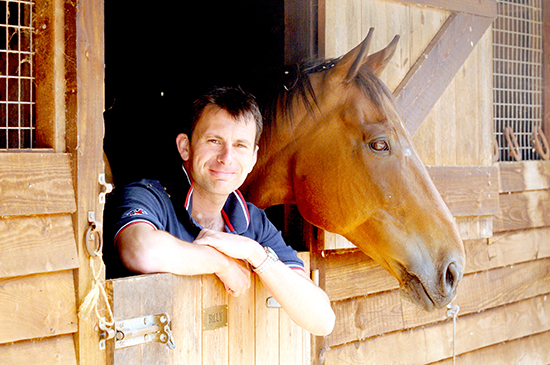 Jon Pitts, a UK-based expert in off-the-horse fitness training whose list of students include Clayton and Lucinda Fredericks, and Paul Tapner
Jon Pitts, a UK-based expert in off-the-horse fitness training whose list of students include Clayton and Lucinda Fredericks, and Paul Tapner
Jon believes that off-the-horse training needs to be very holistic. It’s not just about looking at the muscles. The brain and the simple ability to breathe correctly and efficiently all play a part. “The brain controls the body, and when we are under pressure in elite sport it is critical that the physiology of the brain is not limiting the physiology of the body. The trouble is, we are not designed to ride horses and even the best riders in the world will still subconsciously have an emotional reaction in their brain that stimulates certain physical preferences.” To tackle that, Jon uses a lot of different approaches. He likes to steer clear of the traditional in some respect and get creative. It is important that riders really know what their bodies are doing and how they are doing it; recognise imbalances and then reprogramme the neurological pathways to create a more effective and balanced way to move and control the body. This is where certain off-the-horse exercises come into the equation. These must be function specific so the body learns to move in the more unnatural way that we ask of it when in the saddle. Jon finds it to be of the utmost importance to guide the riders in the transition from the ground exercises back into the saddle, putting the new ideas to work on the horse.
Eckart Meyners is a very well known and respected German professor (www.balimo.info). He teaches movement and health theory as well as equestrian education science at the University of Luneburg, Germany. Meyners has been looking at rider movement for over 30 years and has worked with many top riders including Olympic medallist Heike Kemmer. Eckart tells me that he believes body work off the horse is vital to good riding and has developed his own system of body re-education to allow riders’ bodies to return, in his words, “back to our nature.” Problems arise from stagnant lifestyles and we basically forget how to move. Blockages occur in different parts of the spine that lead to a less than ideal seat. “It is a pity that all over the world they use pilates for fitness and not for body awareness.” Meyners believes that this is key. He has even gone so far as to develop a special stool called the Balimo which has a moveable seat that allows for three-dimensional movement in the pelvis, releasing blockages and allowing the rider to feel a new way of moving. The body movements he uses in his system are not big or terribly strong, but really work on awareness.
Many riders believe body-work off the horse is unnecessary and they are able to get super results without adding this to their already busy schedules. However, it is a practice that is growing in popularity both for the everyday rider and those at an elite level. Busy lifestyles lead to many of us being unaware of what our body is doing. It just gets on and “copes” often in a way that is not beneficial to long-term health or riding. Added to that, the unnatural position the dressage sport demands of riders’ bodies and extra, focussed work may not be such a bad thing after all. In fact, it could transform your riding!
CASE STUDY
Deborah Carr is a Sydney-based dressage rider. At 40 years old, Deborah works full time in an office job and is the mother of two but still finds time for top results in the dressage arena. Her childhood love of eventing gave way to dressage and Deb has competed her mare Venus successfully to Inter 1. Her young horse, Whispering Wizard took her to the four-year-old young dressage horse finals at the Sydney CDI earlier in 2011. Deborah is about to embark on the big tour with Venus and needs some slight improvements in her position to make her transition to Grand Prix. Using one of Jon Pitts’ favourite pieces of apparatus, the fit ball, I ran Deb through some useful exercises for a rider of her background and level:
TOE TAPS
Why?
– To make the legs work independent of the body
– Test core stability
– Disassociation of upper and lower body
How?
– Sit tall on the ball
– Breathe out and raise one foot off the ground
– Breathe in and return to start
– Breathe out and repeat with opposite leg
Watch Out For:
– Make sure you lift the leg from the hip, not the knee
– Keep equal weight in both seat bones as you lift the leg
– Keep ribs still, not moving to counterweight the lifting of the leg
– Keep shoulders aligned above your hips
Photo critique: Deb does a good job here. Her shoulders are straight and knees point forward. I would just encourage her to watch that her rib cage doesn’t pop to the left and she keeps equal weight in both seatbones.
“REINS”
Why?
– Shoulder girdle and upper body stability
– Teaches a “giving” hand without affecting the body
– Core strength to resist being pulled forward by the horse
How?
– Sit tall on the ball
– Breathe out and straighten arms in front, keeping torso still
– Breathe in and return to start position.
(note: I like to make the exercise more difficult by holding small weights in the hands)
Watch Out For:
– Collapsing in the chest
– Unequal weight on seat bones
– Leaning back when arms reach forward
– Collapsing upper abdominal muscles
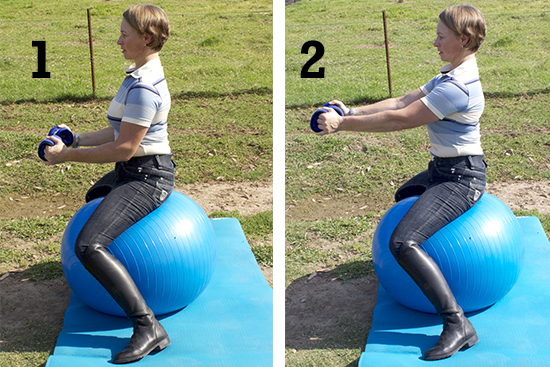 Photo critique: There’s not much to change here. I would only encourage Deb to open through her hips just a little more. Shoulders and hips are nicely in line.
Photo critique: There’s not much to change here. I would only encourage Deb to open through her hips just a little more. Shoulders and hips are nicely in line.
FLAT BACK
Why?
– Works on strengthening the front of the body to help support the back
– Opens up the front of the hips
– Helps teach length through the spine
How?
– Kneel with hands on the top of the ball, lower leg relaxed
– Breathe out and roll your arms along the ball, keeping a straight line between your shoulder and your knee
– Breathe in
– Breathe out and return to start position
Watch Out For:
– Poking your bottom out
– Losing the length through the body
– Taking too much weight into the hands and arms instead of controlling with the body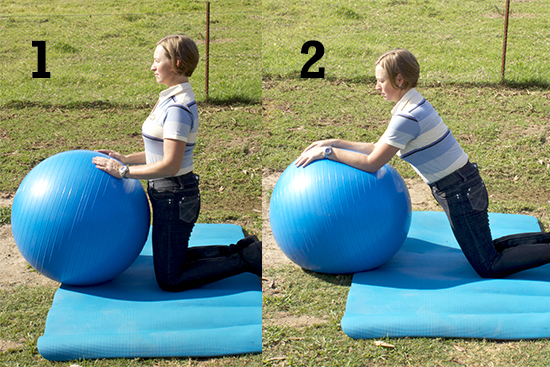
Photo critique: Deb executes this exercise really well, keeping her back nice and straight, tummy tucked and shoulders drawn down.
This article first appeared in the April 2012 issue of THM.



